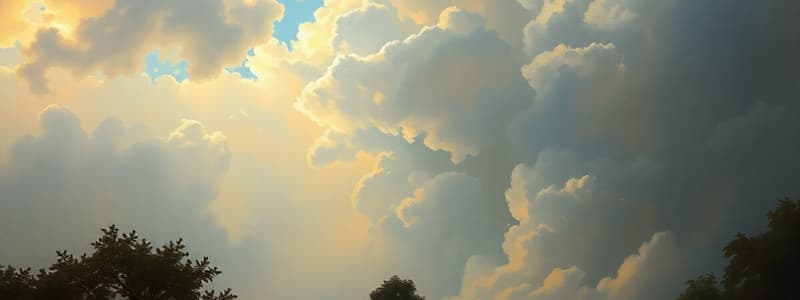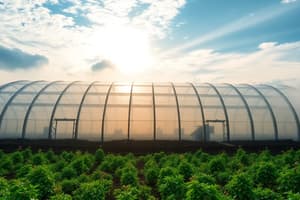Podcast
Questions and Answers
What is the approximate percentage of nitrogen in the air?
What is the approximate percentage of nitrogen in the air?
- 78% (correct)
- 21%
- 1%
- 0.03%
Which gas is essential for human respiration?
Which gas is essential for human respiration?
- Carbon Dioxide
- Oxygen (correct)
- Nitrogen
- Hydrogen
What effect does bubbling carbon dioxide have on limewater?
What effect does bubbling carbon dioxide have on limewater?
- It turns it milky (correct)
- It remains clear
- It turns it green
- It turns it blue
Which of the following describes the layer of gases surrounding the Earth?
Which of the following describes the layer of gases surrounding the Earth?
What process converts nitrogen in the air to soluble nitrates in the soil?
What process converts nitrogen in the air to soluble nitrates in the soil?
What process involves the oxidation of carbon and hydrogen in food material?
What process involves the oxidation of carbon and hydrogen in food material?
Which gas do denitrifying bacteria release into the air?
Which gas do denitrifying bacteria release into the air?
What percentage of air is composed of nitrogen?
What percentage of air is composed of nitrogen?
Which layer of gases surrounds the Earth and absorbs UV radiation?
Which layer of gases surrounds the Earth and absorbs UV radiation?
Which of the following is a utility of carbon dioxide in the air?
Which of the following is a utility of carbon dioxide in the air?
Flashcards
Respiration
Respiration
Oxidation of food's carbon and hydrogen, producing carbon dioxide, water, and energy (heat).
Combustion
Combustion
Oxidation of substances (fuels) with oxygen, resulting in carbon dioxide, water, and energy (heat and light).
Photosynthesis
Photosynthesis
Process where green plants use sunlight to convert atmospheric carbon dioxide and water into carbohydrates (glucose) and oxygen.
Greenhouse Effect
Greenhouse Effect
Signup and view all the flashcards
Denitrifying Bacteria
Denitrifying Bacteria
Signup and view all the flashcards
Atmosphere
Atmosphere
Signup and view all the flashcards
Troposphere
Troposphere
Signup and view all the flashcards
Rare/Inert Gases
Rare/Inert Gases
Signup and view all the flashcards
Lime Water
Lime Water
Signup and view all the flashcards
Nitrogen Fixation
Nitrogen Fixation
Signup and view all the flashcards
Study Notes
- Air is vital for human survival and the environment
Composition of Air
- Nitrogen comprises 78% of air, is colorless and odorless
- Oxygen makes up 21% of air, is colorless and odorless, and essential for breathing
- Carbon dioxide is 0.03% of air, colorless and odorless, produced by human respiration
- Other gases, including noble gases and hydrogen, constitute 1% of air
- Rare or inert gases make up less than 1% of air and include argon, helium, radon, krypton, xenon, and neon
Properties of Air
- Air is colorless and odorless
- Air has weight
- Air is compressible, useful in applications like scuba diving
- Air has mass and occupies space
- Air exerts pressure
Atmosphere
- The atmosphere is a layer of gases surrounding Earth, retained by gravity
- The atmosphere warms Earth's surface by retaining heat
- The atmosphere absorbs UV radiation and reduces temperature extremes
- Atmospheric composition is the same as air composition
- The atmosphere consists of layers, mainly the troposphere, stratosphere, and mesosphere
- The atmosphere includes five layers: troposphere, stratosphere, mesosphere, thermosphere, and exosphere
- The troposphere is the layer nearest to Earth and contains most of the air and oxygen
Importance of Air
- Air provides oxygen for breathing, essential for human life
- Plants use air for photosynthesis to produce glucose
- Air shapes weather and climate
Air Pollution
- Air pollution is the contamination of air by pollutants
- Causes of air pollution include burning fossil fuels, industrial activities, and vehicle emissions
- Effects of air pollution include respiratory problems, acid rain, and global warming
Conservation of Air
- Conserving air is crucial for maintaining a healthy environment
- Ways to conserve air include planting trees, reducing emissions, and using public transport
Key Processes and Substances
- Lime water: A calcium hydroxide solution that turns milky when carbon dioxide is bubbled through it, forming insoluble calcium carbonate
- Nitrogen fixation: Converts atmospheric nitrogen into soluble nitrates in the soil, increasing fertility, accomplished by symbiotic bacteria
- Symbiotic bacteria: Found in leguminous plant nodules (e.g., pea), absorb nitrogen directly from the air and convert it into soluble nitrates, which plants use to produce proteins
- Respiration: Oxidation of carbon and hydrogen in food, producing carbon dioxide, water vapor, and energy (heat)
- Combustion (burning): Oxidation of substances like fuels with oxygen, yielding carbon dioxide, water vapor, and energy (heat and light)
- Photosynthesis: Green plants manufacture food using carbon dioxide and water in the presence of sunlight and chlorophyll, producing carbohydrates (glucose) and releasing oxygen
- Infrared (IR) and ultraviolet (UV) rays: Present in sunlight, heat Earth's surface; carbon dioxide prevents IR rays from radiating out
- Greenhouse effect: Carbon dioxide forms a layer above the Earth, trapping heat radiation and causing a rise in global temperature
- Denitrifying bacteria: Convert dead organic matter to free nitrogen, released into the air
Utility of Components in Air
- Nitrogen: Used for plant growth via nitrogen fixation, flushing food packages (unreactive), and controlling combustion
- Oxygen: Used for respiration in living organisms (oxidizes glucose), respiration in plants, and combustion
- Carbon dioxide: Used in photosynthesis and contributes to the greenhouse effect, warming the Earth
- Water vapor: Minimizes the rate of evaporation and influences climatic conditions
- Rare gases: Helium in observatory balloons, neon in advertisements, and argon in filament bulbs
Air Composition and Balance
- Air is a mixture because it has variable composition, no definite properties, and its components can be separated by physical means
- Released into the air: Carbon dioxide (respiration, burning, decay), oxygen (photosynthesis), nitrogen (denitrifying bacteria), water vapor (evaporation, transpiration)
- Removed from the air: Carbon dioxide (photosynthesis), oxygen (respiration, burning), nitrogen (nitrogen fixation), water vapor (plants, living organisms)
Air Applications
- Oxygen cylinders and tents provide artificial respiration
- Air is used in kerosene stoves and vehicle tires
- Air influences weather (heat and cold waves)
- Evaporation speeds up moisture removal
- Wind helps pollination
Studying That Suits You
Use AI to generate personalized quizzes and flashcards to suit your learning preferences.
Description
Explore the composition of air including nitrogen, oxygen, and carbon dioxide, and its key properties such as being colorless, odorless, and compressible. Learn about the atmosphere, its layers, and its role in retaining heat and absorbing UV radiation to maintain Earth's temperature.




